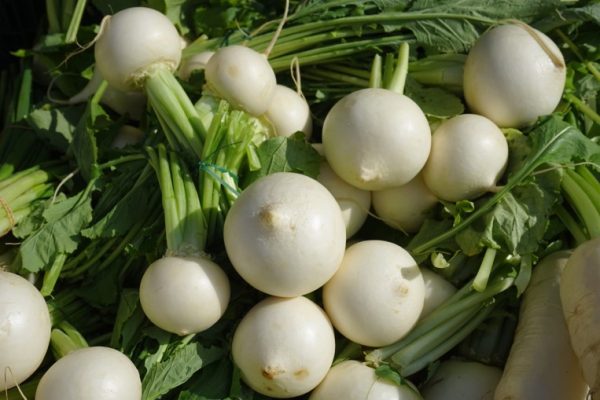
How Healthy Is Root Vegetable Turnip And How It Benefits Our Body
Turnips are root vegetables that belong to the Brassicaceae family, which also includes vegetables like broccoli, cabbage, and kale. They are low in calories but packed with nutrients, offering several health benefits:
- Nutrient rich: Turnips are a useful source of vitamins and minerals, including vitamin C, vitamin K, folate, potassium, and manganese. These nutrients play crucial roles in immune function, bone health, and metabolism.
- High in fiber: Turnips are rich in dietary fiber, which aids digestion, promotes regular bowel movements, and helps in maintaining a healthy gut. Fiber also contributes to a feeling of fullness, which can aid in weight management.
- Antioxidant properties: Turnips contain antioxidants such as vitamin C and beta-carotene, which help neutralize harmful free radicals in the body. Antioxidants protect cells from damage and reduce the risk of chronic diseases like heart disease and cancer.
- Supports heart health: The fiber, potassium, and folate in turnips contribute to heart health. Potassium helps regulate blood pressure, while folate helps lower levels of homocysteine, a compound associated with an increased risk of heart disease.
- Cancer prevention: Turnips belong to the cruciferous vegetable family, known for their cancer-fighting properties. They contain compounds like glucosinolates, known for their potential to reduce the risk of certain cancers, including lung, colorectal, and prostate cancers.
- Bone health: Turnips are a reliable source of calcium and vitamin K, both of which are essential for maintaining strong and healthy bones. Vitamin K is particularly important for bone mineralization and reducing the risk of osteoporosis.
- Anti-inflammatory effects: Certain compounds in turnips, including glucosinolates and vitamin C, possess anti-inflammatory properties. Consuming turnips may help reduce inflammation in the body, which is linked to chronic diseases like arthritis and heart disease.
- Blood sugar regulation: Turnips have a low glycemic index and are low in carbohydrates, making them a viable choice for individuals concerned about blood sugar levels. The fiber content also helps slow down the absorption of sugar into the bloodstream.
- Hydration and skin health: Turnips have a high water content, which helps keep the body hydrated. Adequate hydration is essential for overall health and skin elasticity.
- Versatile and low-calorie: Turnips are a versatile vegetable that can be enjoyed raw in salads, roasted, mashed, or added to soups and stews. They are low in calories but provide important nutrients, making them a fantastic addition to a balanced diet.
Incorporating turnips into your diet can contribute to overall health and well-being. Here are different ways to incorporate turnips in our daily diet.
- Raw: Turnips can be enjoyed raw in salads for a crisp and slightly peppery flavor. Peel and slice or grate turnips, then toss them with other salad ingredients like lettuce, carrots, cucumbers, and a vinaigrette dressing.
- Roasted: Roasting turnips brings out their natural sweetness and adds a caramelized flavor. Simply peel and chop the turnips into bite-sized pieces, toss with olive oil, salt, and pepper, then spread them on a baking sheet. Roast in a preheated oven at 400°F (200°C) for about 25-30 minutes or until tender and golden brown.
- Mashed: Turnips can be mashed like potatoes for a lighter alternative. Peel and cube the turnips, then boil them until tender. Drain and mash the cooked turnips with butter, salt, pepper, and a splash of milk or cream. You can also mix mashed turnips with mashed potatoes for added flavor and texture.
- Stir-fry: Add turnip slices or cubes to stir-fries for a crunchy texture and mild flavor. Heat a bit of oil in a pan, then stir-fry turnips along with other vegetables like bell peppers, broccoli, and snow peas. Season with soy sauce, garlic, ginger, and a touch of honey for a delicious Asian-inspired dish.
- Soups and stews: Turnips can be a fantastic addition to soups and stews, adding flavor and substance. Peel and dice turnips, then add them to simmering broths along with other vegetables, and seasonings. Turnips pair well with ingredients like carrots, onions, potatoes, and hearty greens.
- Pickled: Turnips can be pickled to preserve them and enhance their flavor. Slice turnips thinly and pack them in a jar with a mixture of vinegar, sugar, salt, and spices like mustard seeds or peppercorns. Let the turnips pickle in the refrigerator for a few days before enjoying them as a tangy condiment.
- Gratin: Layer sliced turnips in a baking dish with cream, cheese, garlic, and herbs to create a rich and comforting turnip gratin. Bake until the turnips are tender, and the top is golden brown and bubbly.
- Sautéed: Thinly slice turnips and sauté them in olive oil or butter with garlic and fresh herbs like thyme or rosemary. Cook until the turnips are tender-crisp and lightly browned for a simple and flavorful side dish.
Experiment with these cooking methods to discover your favorite ways to enjoy turnips. They can be a tasty and nutritious addition to your meals, providing a range of health benefits along with their delicious flavor.
Image credit: https://pxhere.com/en/photo/1340780 CC0 Public Domain (published 04/03/2017)
Author: Sumana Rao | Posted on: May 17, 2024
« Use Cucumber To Keep Skin Healthy This Summer Ways To Use Coconut Milk For Skin And Hair Health »






















Write a comment